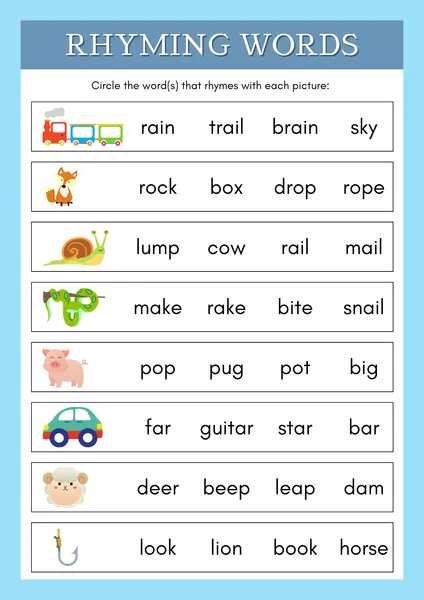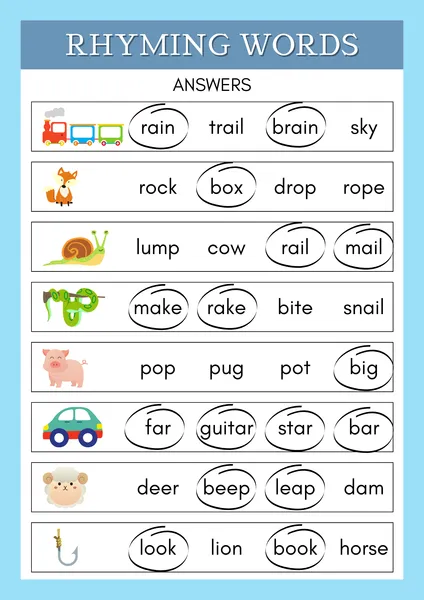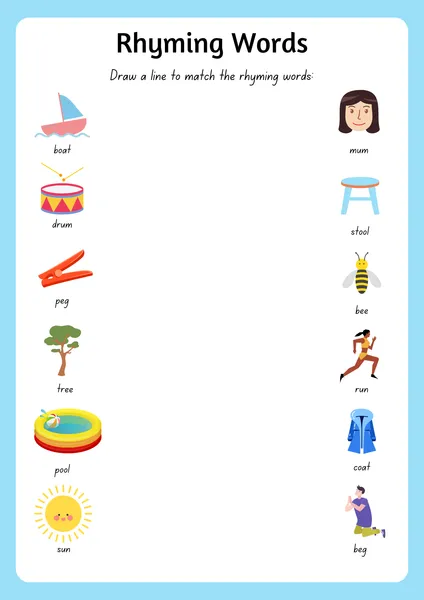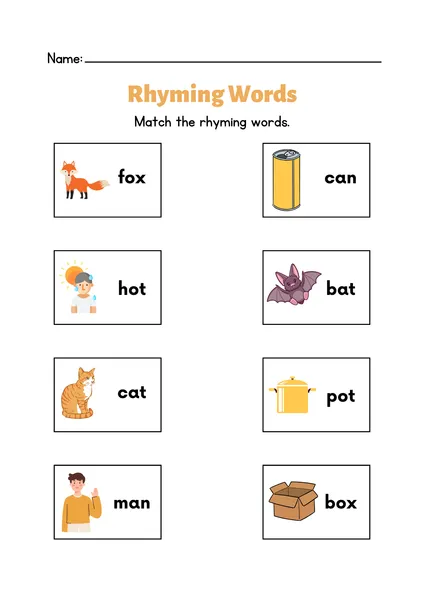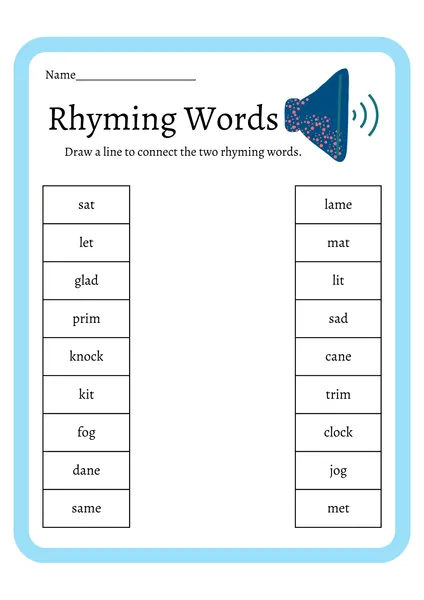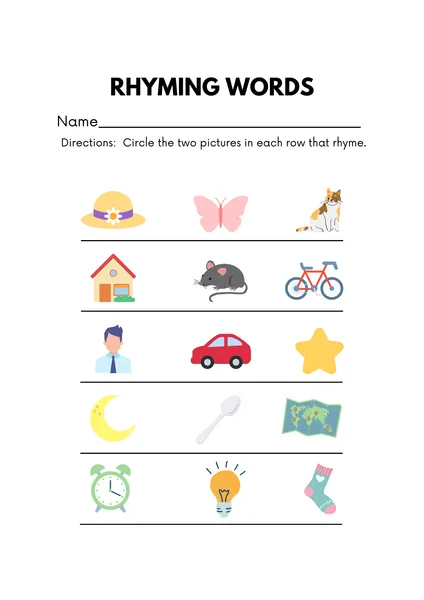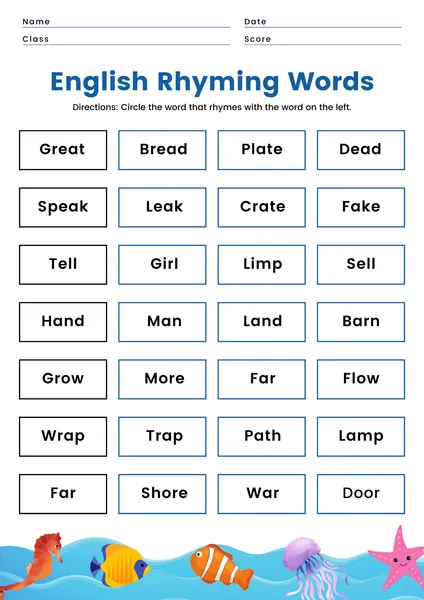Rhyming is an enjoyable foundational component of early learning that enhances phonemic knowledge, expansion of word retrieval, and linguistic interest. Printable rhyming words worksheets for kindergarten may benefit students of the given age group and help them study the concept of rhyming in a fun manner.
Pros of Rhyming Activities for Young Students
Rhyming lessons help children, and symbolical practices increase practical knowledge dramatically instead of wordplay. Here’s a deeper dive into the advantages:
1. Phonemic Awareness:
Sound Recognition:
Rhyming activities help young listeners learn to distinguish one word’s sound (phoneme).
This competence is then the foundational process of reading and spelling. Children find that “cat” and “hat” have similar sound elements during early learning of phonemes, which are the minor language units.
Sound Manipulation:
Aside from identifying the different sounds, rhyming helps children play with them. These are some of the losses that make them understand when words are substituted, such as changing the first sound in “cat” to make the word “bat” or “rat”.
It again becomes important in decoding and encoding, which means reading and spelling work.
Auditory Discrimination:
Rhyming also needs children to recognise similar word sounds; thus, rhyming assists children in attaining proper auditory discrimination. This ability is invaluable in the aspect of pronunciation and understanding of a language.
2. Vocabulary Expansion
Exposure to New Words:
Rhyming can naturally bring children into acquaintance with a more significant number of lexis. This way, they interact with words rarely used in daily conversation, helping expand their vocabulary.
Word Relationships:
Rhyming makes them relate to them, making the children understand that words may share similar sounds and meanings. It enhances their vocabulary knowledge and helps them find aspects of their learning content.
Semantic Connections:
Considering the correlation between words in different rhymed words, children understand that words have the same meaning. For instance, they know that ‘cat’ sounds like ‘hat’ and ‘bat’ before knowing they are all about objects or animals.
3. Reading Readiness
Pattern Recognition:
Such activities help children improve their recognition of patterns when it comes to words. This skill is essential to decoding because children learn patterns on how to read, and in particular, they understand some phrases that have specific letter sequences.
Predictability in Text:
This is because when exposed to rhymes, one will expect the next word to be similar to something familiar to him. This helps children prepare for the text flow as they move from learning to reading to the learning stage.
Phonological Awareness:
Rhyming is one of the components of phonological awareness, which can be characterised as a set of skills related to the phoneme.
4. Love for Language
Playful Learning:
Because some rhyming activities are a form of play, children are familiar with them and have a positive attitude toward languages and reading.
Parents teach children to appreciate the sounds of language and rhythm, which enhances their ability to learn reading and writing.
Creativity and Imagination:
Rhyming makes the students more creative and imaginative. Students enjoy games, such as creating their own rhymes and stupid word associations, as they encourage children’s fancy and interest in words.
Confidence Building:
Practising rhyming exercises improves children’s confidence in their linguistic skills, encouraging them to learn more about English.
Fun-filled Rhyming Activity and Games
1. Rhyme Matching Games
Matching Pairs:
Prepare two sets of picture cards in which one picture can be matched with another based on the rhyming of the names of the pictures.
Lay all the cards on the table face down, get students to pick two cards, and turn them face up to look for rhyming pairs.
Memory Match:
Instead of centring on rhyming words, play with the same picture cards but match them up like a memory game.
Turn all cards face down, then the student can turn two cards simultaneously to match the pair. If two cards form a rhyme, they take the two cards.
Rhyming Bingo:
Make bingo cards with pictures or words that occur in similar rhyming sounds. Read the rhyming words aloud, and ask students to put a cheque or sticker on the image or word on the card that matched between kids.
2. Rhyme Completion Activities
Fill in the Blank:
Leave a couple of sentences half with a rhyming word missing, and have the students select the correct rubric from the options given. For example, The cat sat on the ____.” (mat, chair, book)
Rhyming Riddles:
Make fun and easy riddles with the clues rhyming. For example, “The first part can rhyme with boat; the second part can float. What am I?” (coat)
Rhyming Songs and Chants: Demonstrate how rhyming words can be used in songs and chants. Read More. Call upon the students to clap or stomp the beat.
3. Word Family Exploration
Word Family Charts:
Use charts on prefixes and suffixes like -at, -og, -all. Let students devise the words that should be placed under each family and then write them down.
Wthemd Family Sorting:
Give the students a set of pictures or word cards and make them categorise different word families.
Word Family Building:
First, give one word, for instance, ‘cat’, then let the learners append on a different letter to form new words with the same rhyme pattern as the initial word ‘cat’, such as ‘hat, ‘bat’, and ‘sat’.
Printable Rhyming Words Worksheets for Kindergarten
Engaging in Activities and Games to Practice Rhyming
1. Matching Pairs Worksheets
- Take two columns of the pictures. In this activity, students use a line to link the rhyming pictures.
- Give a set of pictures and a word box. For each image, the student writes the matching rhyming word alongside it.
- Show a picture and a few words. Students encircle the graphic word which rhymes with the picture.
2. Completing Rhymes Worksheets
- Give readers sentences in which some of the words are missing rhyming counterparts. Students complete the blank marked with the correct word from a word box.
- Provide good pictures and half-rhyming sayings. Students write the end of the phrases using a rhyming word.
- Show a rhyming word and a set of pictures. Students colour the image to make it sound similar to the word.
3. Word Family Worksheets
- Here is the word family: bus, mask, cup, dust, blush, was, musk. The following pictures: Students cut out the images identified to be in the word family and colour them.
- Give a word family and some letters. Students add the letters to the word family and develop a new word in this word family.
- Read a set of words and give students a task to categorise them into different word families.
Printable Rhyming Words Worksheets: Best Practices
More than merely functional, printable rhyming word worksheets can help students learn and write, but only if used strategically. Here’s how to use these resources for optimal learning:
1. Start with Simple Rhymes: Gradual Progression
- One-Syllable Wonders: Start with worksheets with at least one print of each word so that children can easily recognise letter-sound patterns such as ‘at/at’ or ‘un/fun’. These are easier for young learners to understand and afford a good starting point.
- Increase Complexity: Provide two-syllable rhyming worksheets as the child gains more confidence and activates prior knowledge of the words (for example, “mitten-kitten,” “rocket-pocket.” Move to harder-to-rhyming words with more syllables or use less frequently heard sounds.
- Consider Individual Needs: Be vigilant in evaluating separate children’s developmental achievements. Some learners may be more prepared for advanced rhymes than others, depending on their level of learning. They should differentiate based on several worksheets that they give indicating the level of difficulty.
2. Use Visual Aids: Support Understanding
- Picture Power: Match each of the rhyming words with properly illustrated, appealing pictures. Pictorial imaging emphasises the relationship between the word and the idea, making understanding and memorising easier.
- Colour Coding: For example, use red for rhyming pairs or word families and black for the other words. This creates an ability in children to look for matching features and find likeness between one word and the other.
- Real-Life Objects: Ideally, link what is done on the worksheet to real-life items and objects whenever possible. For instance, if the worksheet uses “ball/tall”, ensure children can touch balls and tall objects like blocks.
3. Make it Interactive: Hands-On Learning
- Beyond Circling: Encourage active engagement. Have children write in their pictures, illustrate rhymes in pictures, or use cut and paste on rhyming pairs.
- Manipulatives: Further, use tiles, such as letter tiles or magnetic letters, to enable manipulation and enable children to build rhyming words.
- Games and Activities: Worksheets can be followed by other rhyming games and activities for children. For example, after children have finished practising the vocabulary by completing a matching pairs worksheet, they can go to the next set of word pairs to play a memory game.
4. Provide Differentiation: Meeting Diverse Needs
- Variety of Worksheets: Provide multiple worksheets that vary as to the difficulty level, their types, and the kinds of activities they contain. This helps to take into consideration several learning styles and speeds.
- Scaffolding: Make sure learners who find it challenging to understand can be supported through pre-treatment of the words to be used, provision of word lists or cueing, or scaffolding where the learning task is segmented.
- Challenge Activities: For the higher level of training, engage students in creating rhymes on their own, writing rhyming phrases, or developing simple poems.
5. Integrate with Other Activities: Reinforcement and Application
- Rhyming Books: Using rhythm and rhyme, read-aloud books that engage kids with lyrics. Point out the rhyming words and suggest to children to find them:
- Songs and Chants: Read poems, sing songs, and recite chants that contain words that have similar-sounding pronunciations at the end. This allows for the reinforcement of rhyming patterns that have fun employed alongside it.
- Everyday Conversations: Try to use words that rhyme within different conversations and make children notice if two words rhyme. This way, scanning in real-life scenarios instead of just writing poems or songs.
Conclusion
Rhyming word worksheets that include words which can be printed are helpful in the improvement of phonemic awareness, vocabulary, and preparation for reading in kindergartens. Thus, educators should use colorful and exciting strategies and games to help the students develop a love of language and literacy.
